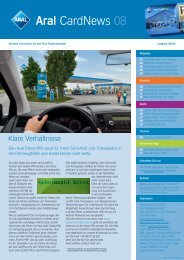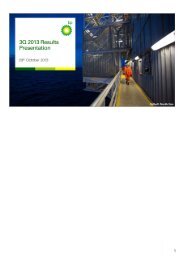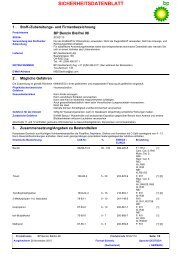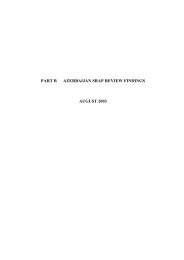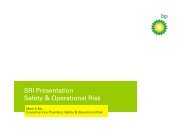Don Field Decommissioning Programme (pdf, 7.8MB) null - BP
Don Field Decommissioning Programme (pdf, 7.8MB) null - BP
Don Field Decommissioning Programme (pdf, 7.8MB) null - BP
You also want an ePaper? Increase the reach of your titles
YUMPU automatically turns print PDFs into web optimized ePapers that Google loves.
DON-<strong>BP</strong>-001<strong>Don</strong> <strong>Field</strong> <strong>Decommissioning</strong> <strong>Programme</strong>6.6.2 Technical FeasibilityThere are no major technical issues identified with any of the decommissioning options.Leaving the umbilicals in situ or selective recovery involves significantly less work thanremoving the umbilicals and therefore carries less technical risk.6.6.3 Safety of PersonnelFor all options involving some decommissioning in situ, the ongoing survey requirementintroduces long-term committed safety risks that dominate the overall risks.Leave in situ with selected removal, including the NLGP crossings, makes littledifference to the overall risk between the leave in situ options due to the dominance ofthe long-term survey. However, as for the pipelines, timing this recovery to coincide withdecommissioning of the NLGP itself would enable the selection of methods that wereless diver intensive and of shorter duration (since protection of adjacent assets would nolonger be a consideration), therefore reducing operational risks. Even with operationalrisks lower than for full recovery options, overall risks for all decommissioning in situoptions are higher due to the effects of long-term survey.Full recovery by cut and lift presents the highest operational risk arising from theoffshore destruct activities and, even in the absence of long-term survey requirements,still presents the highest overall risk for this same reason.Operational risks for full recovery by reverse reel are very much less than for recovery bycut and lift (due to the required offshore working durations being reduced) and, withoutthe long-term survey commitment, present the lowest overall risk.The Quantitative Risk Assessment (QRA) shows that the safety risks associated with allof the options are well within acceptable limits and the margin of error for the analysis.6.6.4 Environmental ImpactsDirect and indirect environmental impacts of activities associated with thedecommissioning of umbilicals can be either short-term impacts directly related tohandling, recovering or recycling of materials, or long-term impacts lasting usually untilthe total degradation of respective materials.Short-term Environmental ImpactsThere are no identified environmental impacts associated with leaving the umbilicals insitu on the seabed apart from the physical presence of the umbilicals.Selective trenching or burial operations would disturb clean sediment and impact benthiccommunities in the immediate vicinity of the present routes.Small amounts of cuttings may be disturbed towards each end of the umbilicals and thismay cause a local impact on the adjacent seabed.Any impact from such activity would be relatively minor and last only a few months.The vessels involved in the work would cause a very localised and transient impact onother users of the sea and give rise to localised atmospheric emissions due tofuel usage.Pipelines10-38 May 2011




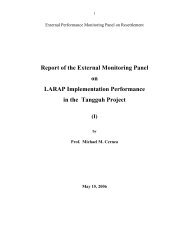
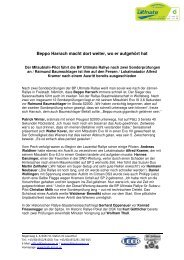
![[PDF] Deepwater Horizon: Accident Investigation Report - BP](https://img.yumpu.com/51697031/1/190x245/pdf-deepwater-horizon-accident-investigation-report-bp.jpg?quality=85)

